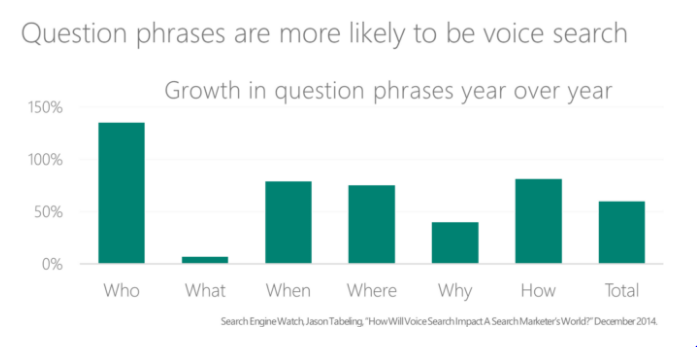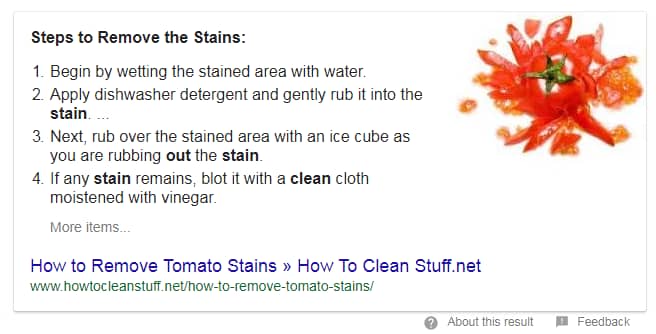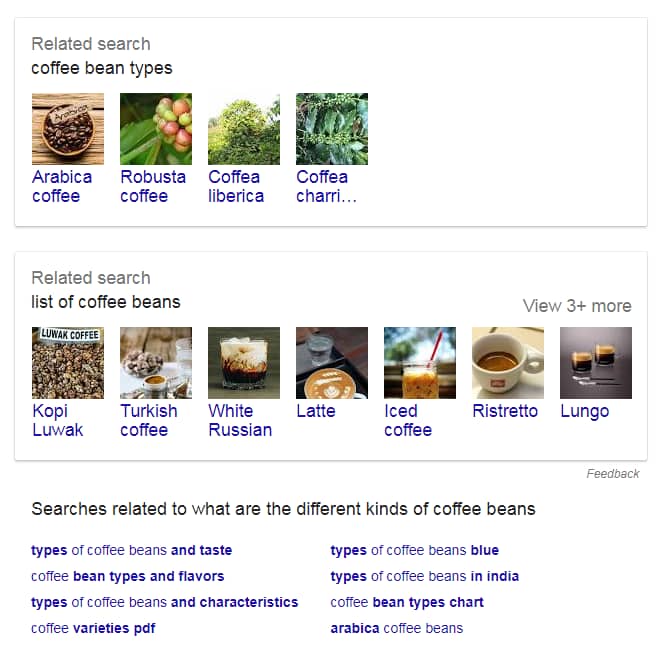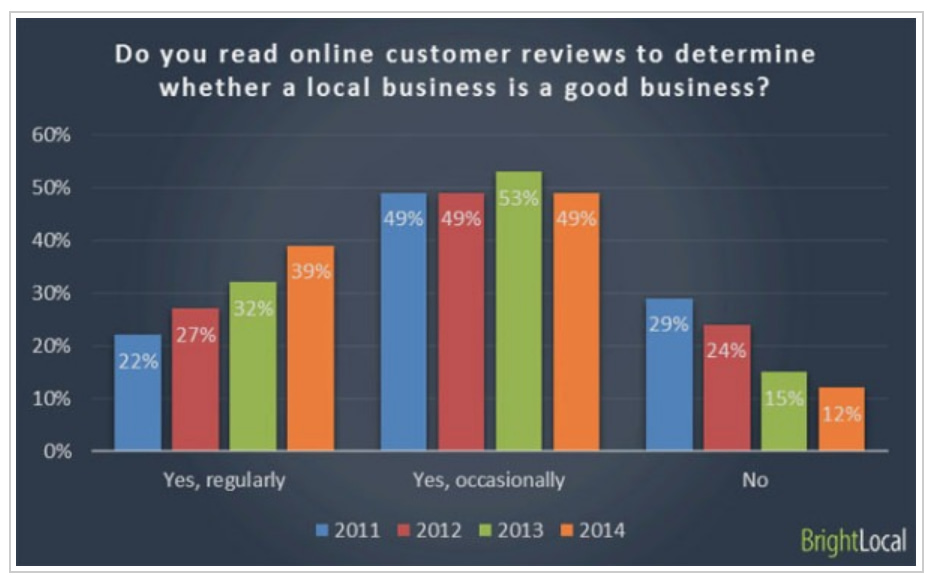The world is getting smaller, especially online.
In fact, location is becoming so important that on many devices, you can’t turn device-location-awareness off!
It’s no secret that AI in search and Voice-Assisted technologies are becoming a mainstay in the digital era but what does this mean for local SEO today? And how can local businesses succeed while the landscape continues to shift under our feet?
In this article, we’re going to look at the most important local SEO strategies that you’ll need to know in 2019 and what you can do to stay on top of the search results and ahead of the competition!
Optimizing Local SEO for Voice Search
With over 40% of adults already using Voice-Search on a daily basis and with almost 2/3rds of users saying they can’t imagine going back to the days before Voice-Assisted technologies, it’s time we understand how we can optimize SEO for Voice Search.
Let’s take a minute to look at some of the main characteristics of voice search and what you can do to optimize for it.
#1. Understanding the Intent Behind Voice Search
When people use voice search, it’s because they want to achieve a result.
This could be finding out what the weather’s like, seeing what’s on their calendar for the day, or finding out how they can go about buying your product.
Voice Search queries typically include a question phrase like what, when, how, etc..

Why is this important?
Well, understanding the types of phrases people are using in the context of your business will allow you to make smarter decisions around the content you put online and as voice search becomes more commonplace, now’s the time to start planning your content accordingly.
What kinds of questions are people asking around your business? One tool that’s helpful in generating keyword and phrase ideas is AnswerThePublic. Simply search for a keyword and let your creative juices flow!
If you can begin to uncover the search intent behind your customer’s voice queries, your business will be in a better position to deliver content that speaks to the problems your customers are wanting to solve.
#2. Voice Search and Local, Mobile Searches
At least 22% of voice searches are done from a mobile device and a large part of that are “near me” searches:
Hey Google, show me coffee shops that are open near me.
In other words, the way voice queries are phrased tends to include more locally-aware words:
Ok, Google, show me sushi places near the Victoria Inner Harbour
The point is, as the world becomes more location-aware, as a local business, it becomes increasingly important to define a robust online business profile (more on that later).
That includes clearly defining all the necessary attributes around your business including store hours, cross streets, and any local landmarks that might help a visitor discover your business.
It also means supplementing your website content with synonyms for your location. So for example, because I’m in Victoria, British Columbia, I might want to include words like ‘Vancouver Island’ in my content.
Anticipating the mobile aspect of voice-search requires that we’ve provided for all the different variations that people may use to discover our business.
#3. How Voice Searches are Structured
One of the keys to optimizing for Voice Search is understanding the way voice search queries are structured:
On average, search queries from a Voice-Assisted device are longer, averaging between 6-10 words long – source
What’s more is that these long-tail search queries are “Natural Language Phrases“.
So, for example, we might type into Google (on a desktop) “Best Fitbit for runners“.
In comparison, using Voice-Assist technology, you’d probably phrase it more like a question: “Hey Google, what are the best fitbits for runners?“.
You have to put yourself in your user’s shoes. Are they search savvy using short keywords? Or are they more conversational using full sentences?
I do believe Google is pretty good at deciphering, but I can’t speak for the other Voice Devices as readily.
Of course, keywords still matter, but if we want to rank for these “naturally phrased” search queries, we have to be mindful of how people are actually performing searches. And don’t forget, any locational or contextual-specific keywords like where and when should be included if at all possible or relevant.
Featured Snippets and SEO
Another good reason to build content around voice-assisted search queries is the possibility of appearing in one of Google’s Featured Snippets.
It has long been Google’s mission to serve the best results to its users. One of the ways it tries to do that is the Featured Snippet.

Featured Snippets or Rich Snippets, as they are sometimes called, appear for about 12% of search queries.
On Voice-Assisted technologies, however, the Featured Snippet is often the only answer you’ll hear!
For certain devices, it will even send that featured answer’s link to the device.
So how do you optimize for the Featured Snippet?
Well, for one, it helps to already be ranking of the first page but the top result doesn’t always mean it will be the Featured Snippet.
It also helps to know what you’re customers are searching and then delivering to them the content they want to see (see the next step).
Also, you have to consider context.
For some businesses, it doesn’t make sense to try for the Featured Snippet, for example, if you’re an e-commerce site or keywords related to your business don’t fit the question-answer format of the Featured Snippet (if that applies to your business, check out the section on Structured Data coming up next).
On the other hand, if your industry lends itself to providing answers to common customer queries, here are a few tips to make appearing in the Featured Snippet more likely:
#1. Use semantic HTML markup
Websites are best understood by search engines when the code underneath what the user sees is clean, clear, and semantically-written.
For example, use a sub-heading element to highlight the question (the user’s search query) and then use a paragraph tag to answer it.
If the answer to a question is better suited to using a list, opt for an ordered or unordered list.
Being semantically accurate will help search engines to understand the format and meaning of your content and avoid possible miscues that might keep your content from being the Featured Snippet.
#2. Target the right keywords
Most of the time, Featured Snippets are triggered by a question (What, How, When).
Using this knowledge, you can start plugging questions into Google around your industry or topic and then checking out the ‘People also ask’ section:

This will give you a ton of ideas about the kinds of questions your customers are asking, and because the ‘people also ask’ section only shows other popular questions, you know you’re on the right track.
You can also keep your eye on Google’s autocomplete suggestions or scroll down to the bottom of the page to see what other related searches are waiting to be capitalized on:

Using Google as your starting point is a great way to get the ball rolling on generating likely search queries that could be your ticket to being the Featured Snippet.
#3. Provide a succinct, clear answer
To be the selected answer, you better have a good answer!
A good answer is one that is succinct, easy to understand, and answers the question in a way that satisfies the search query.
A good way to see how your answer stands up to the test is to compare it to what’s already being featured.
What are they doing in their answer that is earning them a top spot? How is the content laid-out and structured on the page, and in the HTML?
A little trick is to follow the link from the featured answer and right-click on the part of the page where the answer is located and select “inspect element” from the menu to see what HTML is being used.
This will give you an idea of what’s already working. Your task then is improving on that answer!
#4. Bonus Tip
As we talked about in step #1, structuring your HTML markup in a semantic way can help influence whether your content will become the Featured Snippet.
A great way to help in that is to create an FAQ page on your site or add an FAQ section to a particular page of your site.
Not only will you be adding additional content to the page but the format of an FAQ page is perfect for Featured Snippets (just remember to format the title with a heading tag and the answer with a paragraph tag).
Although there’s no guarantee that doing everything right will land you that coveted spot, it will only help your chances!
Using Structured Data to Improve Local SEO
Much of the work we do to improve SEO involves connecting keywords to our target audience but as location becomes an increasingly important factor online, we need to start providing additional layers of information to all the different devices that need to find and understand our business.
Structured Data – special coding markup applied to the various pages of our site – is becoming increasingly important in order to provide internet devices with all the information they need to help connect us to our customers.
Here’s an example of what Structured Data looks like (remember, this is only read by search engines and devices that use it):
<script type="application/ld+json">
{
"@context": "http://schema.org",
"@type": "Organization",
"url": "http://www.example.com",
"name": "Unlimited Ball Bearings Corp.",
"contactPoint": {
"@type": "ContactPoint",
"telephone": "+1-401-555-1212",
"contactType": "Customer service"
}
}
</script>
Although Structured Data can be used to improve our appearance in search, allowing for the inclusion of star-ratings, reviews, extended navigation, breadcrumbs, and other additional features that make our search results more attractive and “clickable”, studies show that less than a third of business are currently implementing Structured Data into their own websites.
Is this due to the difficulties in implementing Structured Data? Could be but as someone who’s implemented this on his own site, generating Structured Data is not beyond the scope of most people.
Google provides a testing tool to verify that your Structured Data is properly formatted and a guide to get you started.
Structured Data can be used to augment search results related to local businesses, books, movies, restaurants and many other types of search results.
The important thing to remember is not to overdo it. Google’s made it pretty clear that the use of Structured Data should represent what’s already on the page.
You can begin your learning by heading over to Schema.org and have a look at what else is possible with Structured Data.
SEO and Accurate, Online Business Citations
Much like how we’ve optimized elements on our website to improve our local SEO, we also have to look outside our website to develop a complete local SEO strategy.
Online business listings and directories provide a means for us to broaden our reach on the Web and further strengthen our SEO profile.
That’s because these types of listings are important to Google as a way to add credibility and relevancy to your online profile.
They are also important for people who use methods other than Google for finding a particular business such as Yelp or YellowPages.
All things being equal, if you haven’t yet claimed your business on these websites and your competitor has, you’re going to have a hard time outranking them.
Here’s a short video that explains what citations are and how they fit into a local SEO strategy:
It’s important to understand that one of the keys to success in claiming these profiles is making sure the information is complete and consistent across all the various platforms. Otherwise, you risk sending mixed signals to Google and other search engines about your business information and this can negatively affect your SEO.
Arguably, the most important online directory to claim is Google My Business but there are plenty of others that deserve attention including directories local and national to you.
By providing these directories with all the relevant business information including keyword rich descriptions of your business’s products and services, optimized photos (where possible), selecting the appropriate category for your business, and so on, you make it easier and more likely that people and technologies can find your business.
The information you use in citation profiles should also be present on your website, especially if you are targeting a local market.
This information doesn’t have to be word-for-word but all elements on and off your website should align and be cohesive.
I find the footer is a great place to include business-specific information such as address, phone, and email info.
Combined with Structured Data and other on-page SEO strategies, claiming our business on these directories is helping humans and computers to better find and understand our business and this gives us more SEO power online.
Reviews and Local SEO
I’ve written before about the importance of reviews when it comes to SEO. That’s because, when it comes to local SEO, reviews matter!
Reviews can impact how high and how consistently you rank in Google’s local-pack. It also affects consumer’s buying decisions.
In general, businesses with the most reviews see the lion’s share of exposure in Google’s local pack, although other SEO factors still play a role.
In terms of how reviews affect customer’s buying decisions, more than ever, people rely on reviews from others before deciding on a business.

Getting reviews for your business doesn’t have to be complicated, either.
You can incentivize customers to leave reviews for your business by offering them a discount or giving them something extra when they leave a review. You can use a Google review generator, or simply ask!
Although, I believe Google reviews provide the best SEO value, other review platforms like BBB, Yelp, and Facebook all help to contribute positive signals around your business.

Any way you slice it, if you haven’t yet made online reviews a part of your local SEO strategy, now’s the time!
Improving local SEO with Behavioral Metrics
Continuing on from the topic of online reviews, the way people interact with the search results also sends clear signals to Google and other search engines.
This includes things like how many clicks a search result sees, how long someone stays on the page after clicking, or how fast someone clicks ‘back’ once they’ve landed on a page (otherwise known as a “bounce”).
The folks at Moz did an experiment to see how Click-through-rate and Bounce rate affected the position of a particular search result in the SERPs.
The experiment asked participants to search for a particular search query than click on that result.
At the beginning of the experiment, the test page was ranking in the #7 spot. After only a few hours, that search result became the #1 search result (later, after the test concluded, the search results “normalized” and the page returned to roughly it’s original position, proving you can only game the system for so long..).
But this experiment illustrates the power of the click and user behavior metrics. Enticing click-throughs and retaining visitors can have a direct impact on our search results.
I touched on ways to optimize CTR and bounce-rate last year, and the principles remain the same, but I’ll go over the main points again:
- Your headline should satisfy the search intent and compel clicks
- The meta description should support the headline and further entice people to click through to your content
- The URL can further entice Click-through if it is relevant to the searchers intent.
- Each of these elements, ideally*, should contain the target keyword
Getting people to click on your page is only half the battle. The other half is getting them to stay on your page!
The appearance (a.k.a readability) and the aesthetic aspect of your website will have some effect on whether a site visitor sticks around.
However, without relevant, accurate content that satisfies the user’s intent, that visitor will likely bounce and send a negative user signal to Google.
Bounces are inevitable, so don’t get too discouraged. The key is to refine the “quality” of the traffic that comes to your site.
As the theory goes, if your site is targeting the right kind of traffic, based on strong keyword research and good SEO, and provides a positive experience for its users through an easy to use and read website, you should experience a healthy bounce rate and send consistently strong user signals to Google instead of negative ones.
The quest for achieving positive user signals usually requires some fine-tuning.
I find Google’s Webmaster Tools to be a good, free way of understanding which queries my site is being featured for. I can also see the approximate CTR:

With this information, I can make smarter decisions about the keywords I’m targeting and begin to find ways to improve the behavioral metrics my website’s sending to Google.
Conclusion
Throughout this article, we’ve looked at a number of local SEO strategies from the perspective of a more locally-aware online world including the emergence of voice-assisted technologies.
We talked about ways to refine our local SEO strategy to respond to locally-sensitive search queries and how to better our chances of being the Featured Snippet answer.
We looked at Structured Data and online citations as a way to add depth and richness to our content as well as ensure more cohesion and relevancy across the online universe.
Finally, we talked about the importance of online reviews and sending quality user signals to Google as a way to outrank your competition.
By better understanding the way people use search today, we can better position ourselves to take advantage of how search results are displayed and better connect with our target customers.
After all, that’s what SEO is all about!
Need help? Take a look at our Local SEO service where we help businesses like yours dominate the local search results pages!




